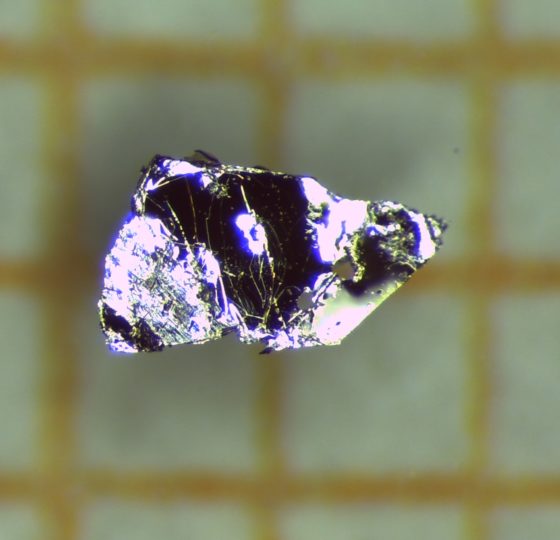First ever antiferromagnetic topological insulator discovered

Topological insulators are materials with special universal properties, which are protected against perturbations. Such properties are theoretically described by topology, a branch of mathematics concerned with the properties of geometrical objects that are unchanged by continuous deformations. Topological insulators are electronic materials that have a bulk band gap like an ordinary insulator but have conducting states on their boundaries, i.e., edges or surfaces. The conducting surface is not what makes topological insulators unique, but the fact that this surface state is particularly robust, potentially due to some symmetry like time-reversal.
On the other hand, some metals, alloys and transition-element salts exhibit a form of magnetism called antiferromagnetism. This occurs below a certain temperature, named after Louis Néel, when an ordered array of atomic magnetic moments spontaneously forms in which alternate moments have opposite directions. There is therefore no net resultant magnetic moment in the absence of an applied field. This ordered arrangement of magnetic moments in a material normally prevents the formation of the kind of electronic order associated with a topological insulator.
We should conclude, then, that an antiferromagnetic topological insulator (AFMTI) is, if not impossible, very unlikely to exist. And this would be most unfortunate because the combination of antiferromagnetic properties (magnetoresistance, spin torque, or ultrafast dynamics) combined with those of topological insulators hints to signi cant advances in novel electronics.
But that an AFMTI would not exist is a conjecture. And, as in the case of mathematical conjectures, a single counterexample suffices to prove it wrong. Actually, the possibility of the existence of an AFMTI was predicted in 2010. Now, an international team of researchers using state-of-the-art ab initio techniques and Monte Carlo simulations along with the structural, transport, magnetic, and photoemission measurements has discovered 1 the first ever AFMTI compound, manganese bismuth telluride (MnBi2Te4).
Crystalline MnBi2Te4 manages to combine these seemingly incompatible magnetic and topological orders. When cooled, the material becomes magnetic, and yet displays a kind of topological insulating behaviour. Unlike an ordinary topological insulator, for which every surface is conducting, such an antiferromagnetic topological insulator has surfaces that are conducting or insulating, depending on how the specific surface cuts through the alternating pattern of spins. 2.
Built of septuple layer blocks stacked along the [0001] direction and weakly bound to each other by van der Waals forces, MnBi2Te4 develops an interlayer antiferromagnetic state, in which ferromagnetic Mn layers of neighboring blocks are coupled antiparallel to each other, while the easy axis of the staggered magnetization points perpendicular to the blocks. As an outcome of this discovery, a number of fundamental phenomena are expected to either eventually be observed, being among them quantized magnetoelectric coupling and axion insulator state or become accessible at elevated temperatures, like the quantum anomalous Hall effect and chiral Majorana fermions.
Author: César Tomé López is a science writer and the editor of Mapping Ignorance
Disclaimer: Parts of this article are copied verbatim or almost verbatim from the referenced research paper.
References
- M. M. Otrokov, I. I. Klimovskikh, H. Bentmann, D. Estyunin, A. Zeugner, Z. S. Aliev, S. Gaß, A. U. B. Wolter, A. V. Koroleva, A. M. Shikin, M. Blanco-Rey, M. Hoffmann, I. P. Rusinov, A. Yu. Vyazovskaya, S. V. Eremeev, Yu. M. Koroteev, V. M. Kuznetsov, F. Freyse, J. Sánchez-Barriga, I. R. Amiraslanov, M. B. Babanly, N. T. Mamedov, N. A. Abdullayev, V. N. Zverev, A. Alfonsov, V. Kataev, B. Büchner, E. F. Schwier, S. Kumar, A. Kimura, L. Petaccia, G. Di Santo, R. C. Vidal, S. Schatz, K. Kißner, M. Ünzelmann, C. H. Min, Simon Moser, T. R. F. Peixoto, F. Reinert, A. Ernst, P. M. Echenique, A. Isaeva and E. V. Chulkov.(2019) Prediction and observation of an antiferromagnetic topological insulator. Nature doi: 10.1038/s41586-019-1840-9 ↩
- R.S.K. Mong & J.E. Moore (2019) Magnetic and topological order united in a crystal Nature doi: 10.1038/d41586-019-03831-7 ↩